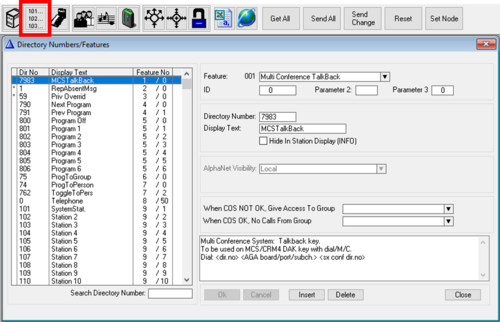Difference between revisions of "Directory & Features (AlphaPro)"
From Zenitel Wiki
| Line 12: | Line 12: | ||
* '''Feature''': The feature number specifies what feature to activate when the assosiated Directory Number is dialed. See [[AlphaCom Feature List]] for a detailed description of each feature. | * '''Feature''': The feature number specifies what feature to activate when the assosiated Directory Number is dialed. See [[AlphaCom Feature List]] for a detailed description of each feature. | ||
** '''ID''': Additional property or sub-ID for the feature. When several directory numbers are using the same feature, they can be separated by different IDs. | ** '''ID''': Additional property or sub-ID for the feature. When several directory numbers are using the same feature, they can be separated by different IDs. | ||
| − | ** '''Parameter 2''': | + | ** '''Parameter 2''': For some features additional properties can be defined using this field |
| − | ** '''Parameter 3''': | + | ** '''Parameter 3''': For some features additional properties can be defined using this field |
* '''Directory Number''': Enter the desired directory number. The number can be from 1 to 8 digits. If the new number is already in use, or will mask other numbers, you will get a warning. | * '''Directory Number''': Enter the desired directory number. The number can be from 1 to 8 digits. If the new number is already in use, or will mask other numbers, you will get a warning. | ||
* '''Display Text''': Caller ID. The display has space for 16 characters. The directory number + space is automatically added to the display text entered. This means that with a 4-digit directory number, only 11 characters are available for the text. | * '''Display Text''': Caller ID. The display has space for 16 characters. The directory number + space is automatically added to the display text entered. This means that with a 4-digit directory number, only 11 characters are available for the text. | ||
Revision as of 15:45, 21 December 2017
The Directory and Features table contains the all directory numbers for stations and features in the system.
From this menu one can modify a directory number, and add new directory numbers. A directory number can contain anything from 1 to 8 digits. If masking occurs, you will be warned (e.g. if you enter number 10, it will mask all numbers 100- 109, or 1000 to 1099).
Digits During Conversation: These are features that can be activated during a conversation, such as "6" for Door Opening or "2" to put a call On Hold.
- Feature: The feature number specifies what feature to activate when the assosiated Directory Number is dialed. See AlphaCom Feature List for a detailed description of each feature.
- ID: Additional property or sub-ID for the feature. When several directory numbers are using the same feature, they can be separated by different IDs.
- Parameter 2: For some features additional properties can be defined using this field
- Parameter 3: For some features additional properties can be defined using this field
- Directory Number: Enter the desired directory number. The number can be from 1 to 8 digits. If the new number is already in use, or will mask other numbers, you will get a warning.
- Display Text: Caller ID. The display has space for 16 characters. The directory number + space is automatically added to the display text entered. This means that with a 4-digit directory number, only 11 characters are available for the text.
- Hide in Station Display: When the option is activated:
- For all station directory numbers (except Call Requests): The station name and number are not included in the directory lists for the stations.
- For Call Requests: In the called station the directory number for the calling station is shown, but the station name is “hidden” and the display text for the feature is shown. For example, this is used to distinguish between different Call Request numbers: Lift Call, Cell Call, Door Call, etc.
- AlphaNet Visibility: Set according to the Cluster programming.
- When COS NOT OK, Give Access to Group: Is used to give a group of stations access to features that are not included in the stations’ Class of service.
- When COS OK, No Calls From Group: Is used to restrict a group of stations access to features even if the feature is included in the stations’ Class of service.

